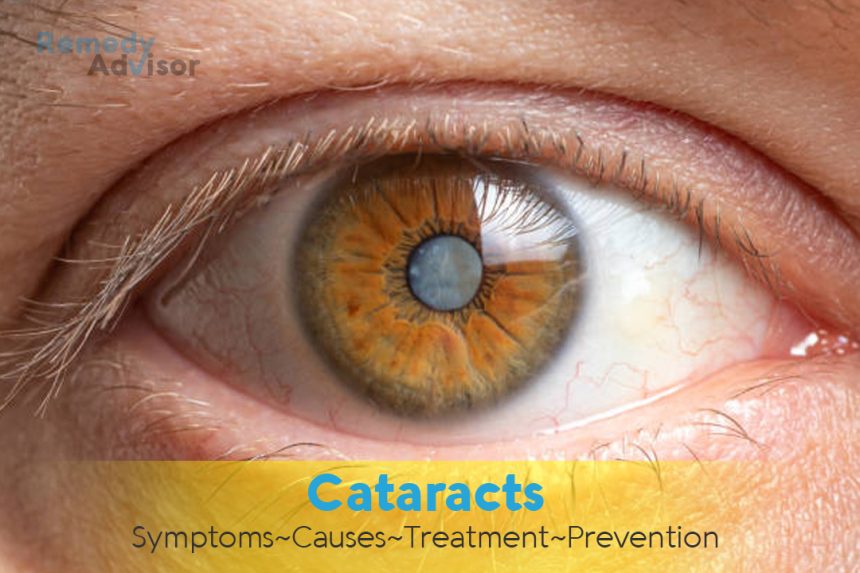What is it
The lens of your eye, which focuses light on the retina at the back of the eyeball, is normally colorless and clear. With age, however, the lens may grow cloudy and opaque, impairing your vision a condition called a cataract. Although cataract surgery, in which the lens is removed, is almost always successful, cataracts are still a major cause of treatable blindness worldwide. Li the United States, over a million cataract operations are performed each year, accounting for about 12 percent of the entire Medicare budget.
Until recently, cataracts were thought to be an inevitable part of growing older: as you age, the lens of your eye deteriorates. Now, however, there’s hope that with good health habits you may be able to postpone or in some cases prevent cataracts.
Symptoms
- Gradual, painless blurring and/or dimming of vision.
- Increased sensitivity to light; poor vision in sunlight or glaring light (such as car headlights).
- Halos encircling lights; sometimes the impression of a film over the eyes.
- Diminishing color perception (as cataracts progress).
- In advanced cases, cloudy appearance of the lens, so that the normally black pupil turns milky white.
What causes it
Though aging is the single greatest risk factor, lifelong exposure to ultraviolet light appears to be a primary cause in promoting cataracts, which are most common in regions where the duration and intensity of sunlight are greatest.
In addition, it’s long been suspected that smoking increases your risk of cataracts, and that the risk rises with the number of cigarettes smoked. In 1992 the Journal of the American Medical Association published two studies (one involving 17,000 male physicians, the other 69,000 female nurses), both of which showed a strong association between cigarette smoking and cataracts, with the heaviest smokers running the greatest risk. In an accompanying editorial Dr. Sheila West of the Johns Hopkins Hospital in Baltimore estimated that at least 20 percent of all cataracts could be attributed to smoking.
Finally, what you eat may affect your risk of cataracts. It’s suspected that in cataract formation, the lens of the eye is damaged by free radicals. These are highly reactive oxygen molecules created by ultraviolet light, cigarette smoke, and other environmental factors as well as by the normal process of oxidation in the cells themselves. The body combats the destructive action of free radicals with the so-called antioxidants. Among the most essential of these chemical “good guys” are three nutrients vitamins C and E and beta carotene (the plant form of vitamin A). Eye fluids are rich in vitamin C, presumably a protective factor.
In younger people diabetes can cause cataracts. And taking certain medications (such as corticosteroids for inflammation) for a long period of time is linked to cataract formation in some people.
What if you do nothing
Cataracts will usually worsen gradually, and eventually you may need surgery to correct the problem. But in most cases cataracts develop very slowly, and you may be able to postpone surgery or avoid it altogether. In recent years increasing knowledge about the risk factors for cataracts makes it possible that their rate of progression can be slowed even further.
Home remedies
Surgery is the only true cure for cataracts, but if cataracts aren’t interfering with normal activities, surgery can be postponed, sometimes indefinitely. In the meantime you can take steps to slow or minimize the impact of cataracts on your vision.
Prevention
The following steps may help forestall or prevent cataracts as you grow older. Because the causes of cataracts are not completely understood, there is no guarantee that these measures will help. But they may, and some have obvious auxiliary benefits, including a lower risk of some cancers and heart disease.
Wear ultraviolet-protective sunglasses
This is the most important step you can take to prevent additional damage to your eyes. Sunglasses with lenses tinted yellow, brown, or amber will absorb blue light, which is the light most readily scattered and so transformed into glare by incipient cataracts.
Outdoors, wear a hat with a brim or visor
The right hat can reduce glare. Sitting under an umbrella also helps minimize glare. Try to stay in the shade as much as possible rather than in direct sunlight.
If you smoke, quit
No one knows exactly how smoking damages the lens, but smokers are about twice as likely to develop cataracts as nonsmokers.
Eat a diet high in vitamins C and E and beta carotene
In other words, eat plenty of fruits and vegetables. Broccoli, cantaloupe, all citrus fruits, carrots, red bell peppers, sweet potatoes, berries, and leafy greens like spinach, turnip greens, and arugula are especially good sources. A high intake of spinach which is also rich in folacin seemed most consistently associated with a lower risk. And in one study, nurses who had taken vitamin C supplements for 10 years had a lower risk of cataracts.







